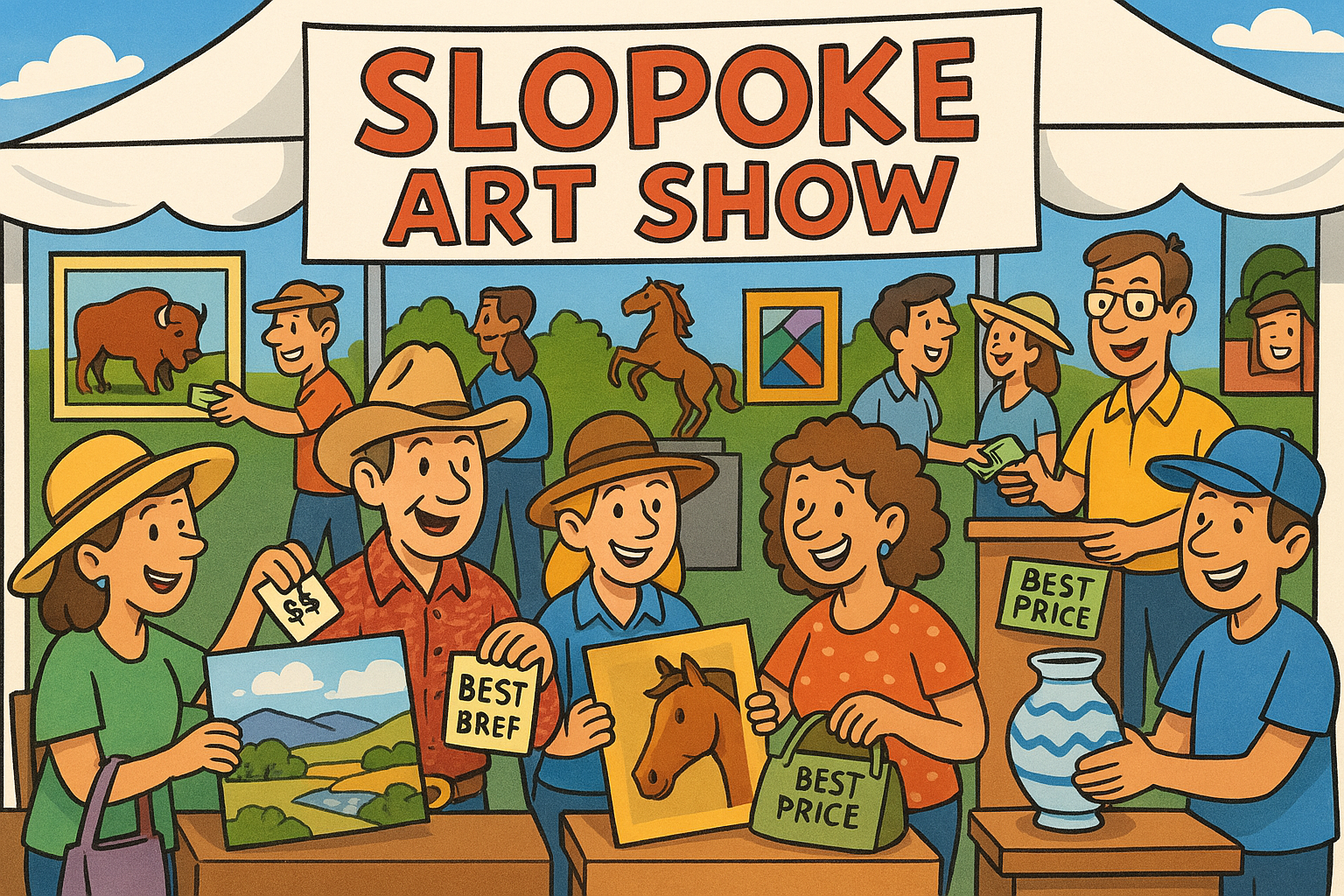An ART Blog
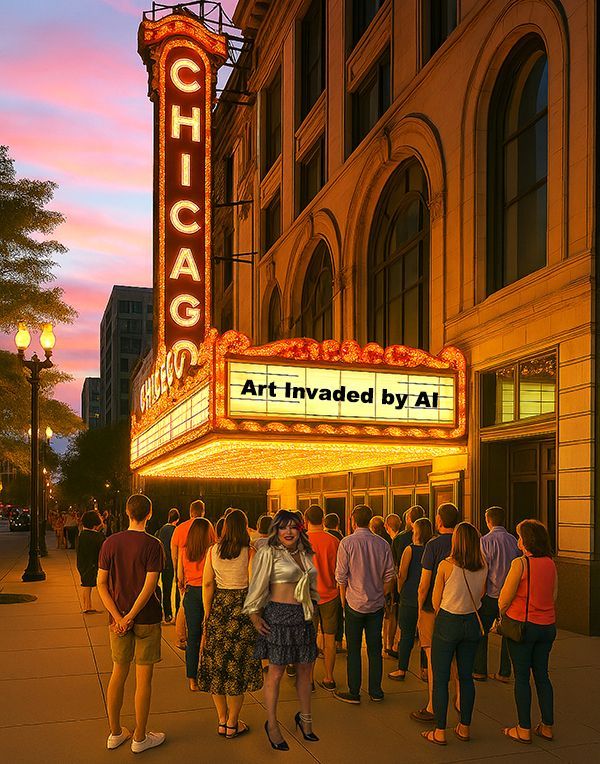
Is AI A Threat to the Art Market?
by T.B. Burgher, II
August, 2025
I have come to believe that the operative word in Artificial Intelligence (AI) is “artificial.” Whether or not it is “intelligence” remains argumentative. To the extent that “intelligence” is limited to the definition of an ability to acquire, understand, and use knowledge, then it certainly can describe AI as we understand it today. However, if you expand the definition to include reasoning: the power of comprehending, inferring, experimenting, imagining, or thinking in an orderly and rational manner, then perhaps artificial – as in “fake” - again supersedes intelligence as the operative word. So, how might this new digital tool affect the art market?
Recently, I captured a photograph of the Piedras Blancas Lighthouse from a distance. To my eye, it had the potential for a nice painting. This is an intelligent act that
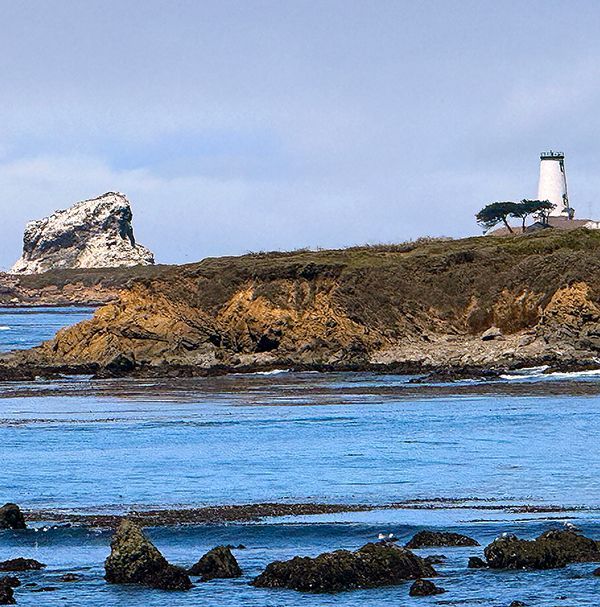
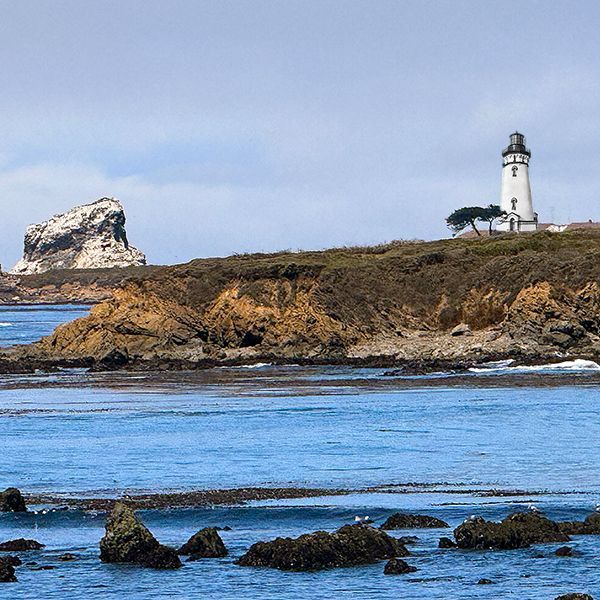
AI cannot perform. However, the lighthouse had been decapitated in 1948 due to some
earthquake damage. I looked for a pre-1948 photograph and copied it to show the missing top 30 feet and pasted it into my photograph to create a more pleasing image. Again, this decision was a spontaneous, intelligent act that AI could not perform without human instruction.
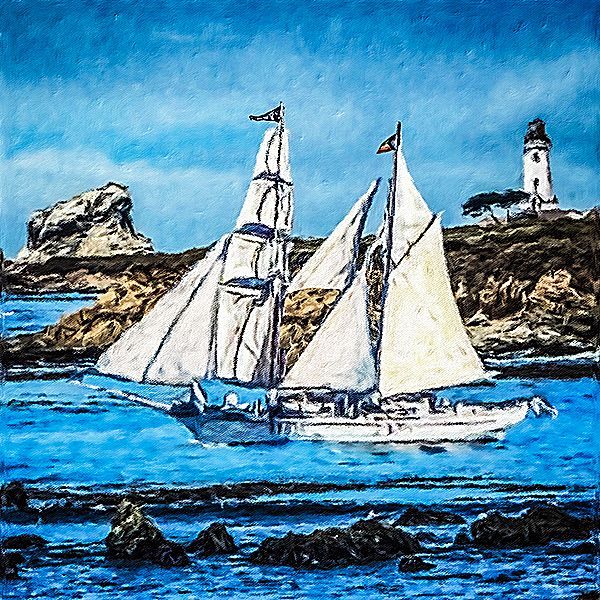
A few days later, I happened to capture a blotchy photograph of the Brigantine Exy Johnson sailing past Santa Barbara a long way from shore in choppy seas. I thought somehow adding this to the Piedras Blancas photograph would convert a nice image into a spectacular image. Again, intelligent decision and imaginative forethought actions that AI is incapable of without human reasoning and instructions and the provision of the actual image. AI might operate a camera but could not make an independent decision on what or how to photograph. However, the best all my editing and filtering tools could do was make a coarse composite image suitable only as a preliminary sketch for a future painting.
Dissatisfied with what I perceived as a great image underachieved, I resorted to AI – in this case Microsoft’s CoPilot – by attaching my photo image with the brilliant instruction: “clean up the attached image and make it look like a professional photograph.” Approximately 3 minutes later, this image appeared for downloading.
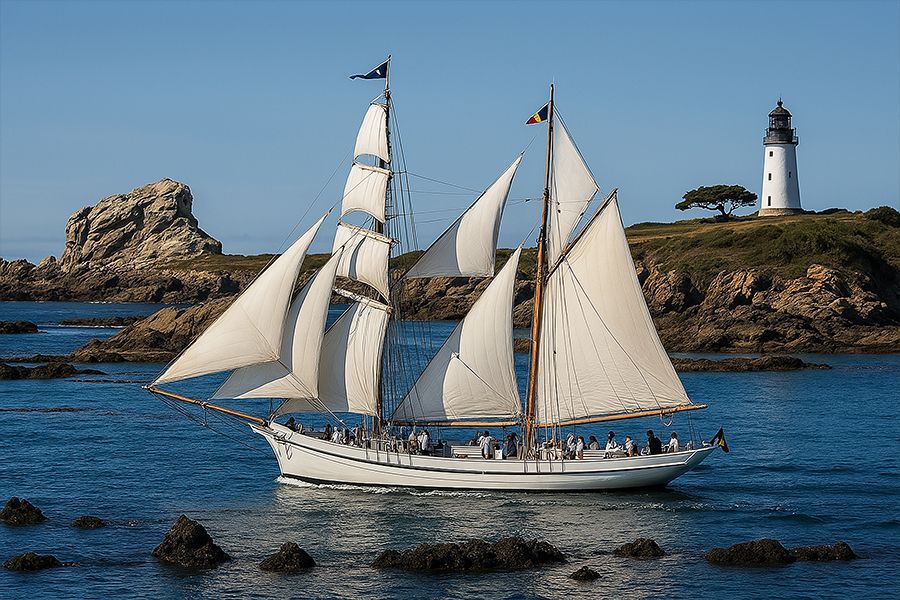
I was pleasantly astounded. This image exhibited the quality of a fine Currier & Ives print. However, it was not an intelligent, re-editing of my photograph but a replacement of similar shapes, perhaps a found image of the same Brigantine. Note that the sun angle has changed; there are no shadows of the masts on the sails, and the lighthouse isn’t quite the same. Piedras Blancas rock is not white! Nevertheless, it is a striking image that perhaps someone would want to purchase. But who owns the copyright and has the rights to sell it now? It is similar to and better than my photograph so ostensibly it is not my work. But Copilot would never have come up with this image were it not for my previous work with photographs, compositing, and instructions. Who gets to sign this artful image as their work product? So, one effect on the Art Market is ownership of intellectual property when AI is involved.
Another artist gave a minute’s worth of instructions to ChatGPT to create an image reminiscent of a Norman Rockwell Saturday Evening Post cover. The AI art shown here appeared for download within minutes.

They titled it: "The New Fashionistas," showing some Gen-Z youth making fun of a Baby Boomer’s attire The resulting image was convincing and even included Rockwell’s name but not in his signature format. This artist might have claimed ownership of this image because it would not exist without their original idea and subsequent instruction.
I am not sure I agree. Why? Because prior to the introduction of PowerPoint, if, let’s say, an engineer needed an illustration for a presentation of a device or scenario that did not yet exist, he sat with an artist in the Art Department and described in detail what it was that he was inventing and what he thought it might look like. After some back and forth, the artist produced a painting that could be used for a viewgraph presentation. The idea was for the device or scenario belonged to the engineer, but the painting was the work product of the artist. If it was a freelance artist, then the artist signed it and owned it. If in a corporate enterprise, then the company owned the intellectual property lock, stock and barrel. However, just giving instructions to another entity about your idea doesn’t make the resulting image your work product. Or does it?
Artificial Intelligence is fun to “play” with in the art domain, so much so that it can also be a colossal waste of time. The danger may lie in the unscrupulous individual who uses someone else’s idea and directs AI to modify it somewhat and then declare the resulting work to be their own and sell it on the open market. As many know, the art market is rife with people who copy another’s work and try to sell it as their own. Order a Vincent van Gogh “Starry Night” from one of the many Chinese art factories. Often, they are so good that you would have to perform a materials analysis to determine that it was not what it purports to be. Unfortunately, AI may make such plagiarism widespread in the future art market. This might devalue original human-created art in the customer’s mind making it even more challenging to make a living as a fine artist. In my mind, however, the first issue needing to be resolved and defined is: who owns an AI-created or AI-assisted image.
NFTs in the Art Market
by T.B. Burgher, II
I do not support NFTs. Ask a lawyer before you commit to anything to ensure you do not lose your rights to your own intellectual property. I investigated NFT's when they first emerged in the art market, and I found them to be merely an obscure means to separate people from their money. NFT means Non-Fungible Token which means unlike cryptocurrency it cannot be exchanged for anything else of value. As you may know, Bitcoin is based upon 57,000 unique digital codes tracked in a ledger called a block chain. The original author or programmer of these codes is unknown. The theory is that there are a limited number of assets (57,000) and the block chain ledger locks down who owns watch one. Therefore, they are assumed to have value. However, what you own and have to sell is a piece of digital code or a piece of a piece of digital code. In short, effectively you can't see it, feel it, taste it, smell it or hear it ... but you "own" it because you paid money to someone to buy "it." And if you track Bitcoin, it fluctuates wildly in value at inflated value (Today: a bitcoin is valued at $107, 418.) It plays on the same human emotional need to see if one is favored by Fate as that which drives the urge to buy lottery tickets. Now, NFTs are similar. As once explained, (my example) a recent Monet sold at auction for $12 million. An NFT purveyor who might (or might not - there's the scam) own that Monet might sell 240 NFTs to subscribers for $50,000 each. Each person would then own 1/240th of that painting. You can't hang your 1/240th Monet on the wall, you can look at a digital image on the computer (but you can do that for free) and someday you might be able to sell your 1/240th Monet to someone else for $55,000 ( a 10% ) if you can find someone who wants to buy into the scheme. The NFT purveyor presumes and tells you that there are plenty of buyers who would love to own a 1/240th share of the Monet. Imagine if it was an NFT for an unknown artist. Whether a person buys into that logic or not is their own business. I do not. I'd rather invest $50,000 if I had it in Lockheed Martin or Boeing, etc. However, in your case, you have someone who wants to give you money for your art. If your art is going unsold in the closet, then why not separate this individual from his money. It now comes down to the terms and conditions to which you agree. And, they may take your art and never pay you.Therefore, discuss this with a lawyer before going forward.
Wikipedia has a long piece on NFTs. If you haven't already, I recommend you read it. In summary, it states: "A non-fungible token (NFT) is a unique digital identifier that is recorded on a blockchain and is used to certify ownership and authenticity...as a new class of investment asset. By September 2023, one report claimed that over 95% of NFT collections had zero monetary value. ..."
The digital world will continue to evolve at speeds hard for us to keep track of. The US Government looks like it may create a "digital dollar" called "Stable Coin." As its name implies, unlike Bitcoin and their ilk, this will have a stable monetary value, be fully fungible, and be based on the value of the United States annual GDP and history of financial integrity, not on an arbitrary limitation of digital codes created by an unknown author. Remember that if it seems too good to be true, it is!
My Vision of Art of the American West
T.B.Burgher, II
After retiring from a very enjoyable 45-year career in military electronic systems, I started a second career in the Art world by buying n Art Gallery in Pismo Beach. Having owned and operated this fine art gallery for 12+ years (sold in 2020), I can confirm what I suspect a professional artist already knows. Most people will buy a recognizable landscape or seascape no matter what style the artist (realism-to-abstract) chooses. Despite the fears of the California Art Club and other organizations that realism was being supplanted by abstract or other forms of graphic art, we always found that traditional art with identifiable subject matter outsold all other styles. Some time ago while a fine art Gallery owner, I began to avoid the label "western art" because buyers, not necessarily astute buyers, would state that they didn't like western art because it was all "cowboy and Indian" stuff. They were instantly confused when asked what they would label a seascape of Big Sur. Thus, we evolved the theme, "Art of the American West," which could be western abstract, mainly due to the palette being so different from that of the East Coast, or it could be a scene of a tagger painting graffiti on a city warehouse wall in south LA, or a native American resident of South Dakota protesting the route of the Canadian pipeline. So, an image San Francisco Bay is western but Narragansett Bay is not because the landscape, the watercraft, the architecture and the colors (esp. blues, yellows, and greens) are so different that the image of one would never be confused with the image of the other.
In my mind, the West is defined by its unique history (dominated by 17th Century presumption of eminent domain), variety of cultures, attitude, weather, wildlife, peoples, expanse, geography, and original law (Spanish vs English) among other characteristics. I believe this is why it is so distinct in people's imaginations. Modern day cowboys such as Steve Jobs, Elon Musk, Jeff Bezos, and many others flourish in the American West because of an expansive attitude that they can do anything. Having grown up in the East, I can attest that you can only do “somethings in life” there. Try to image Elon Musk starting Tesla in Massachusetts or Delaware.
In addition to the gallery in Pismo Beach, we have presented the SLOPOKE for 14 years now. I have also either attended or represented artists in the annual Los Angeles Art Show since moving here in the early 1990’s. When I first encountered the LA Art Show, it was a "western art" show held in a Santa Monica Airport hangar. When it moved to the LA Convention Center, it became mostly a "modern art: graphic/abstract" type show yet with traditional western realism on exhibit by Abend, Arcadia, Blue Rain, Slopoke and M.S. Rau galleries. In that environment, attracting 20,000+ visitors, Slopoke as a gallery representing 5-6 of the same type of artists SLOPOKE the show has always done pretty well. So, certainly some people visit an art show with an idea of what they are looking for but certainly not most. Here are some of the abstract works artists that have exhibited with us in the past:
Artists setting out to paint the story of the American West seem irresistibly drawn to creating the scenes they are familiar with from course work, museum visits, or early TV series which are very much in line with the work that artists such as Charles Russell and Frederic Remington created without necessarily thinking that they were merely recording their time and the world around them. We have urged artists to begin thinking about and painting the American West of today - some of it may look much like that of yesterday - but much of it is quite different yet still reflecting what makes the American West the West. It is a challenging mission because many artists seek to create a pretty western picture. Painting the traditional western subjects in the traditional styles doesn’t really inform future generations what the American West was like in the 20th and 21st Centuries. To encourage more experimentation, we established an award last year sponsored by Southwest Art magazine laboriously titled: Best Depiction of the 21st Century American West.
